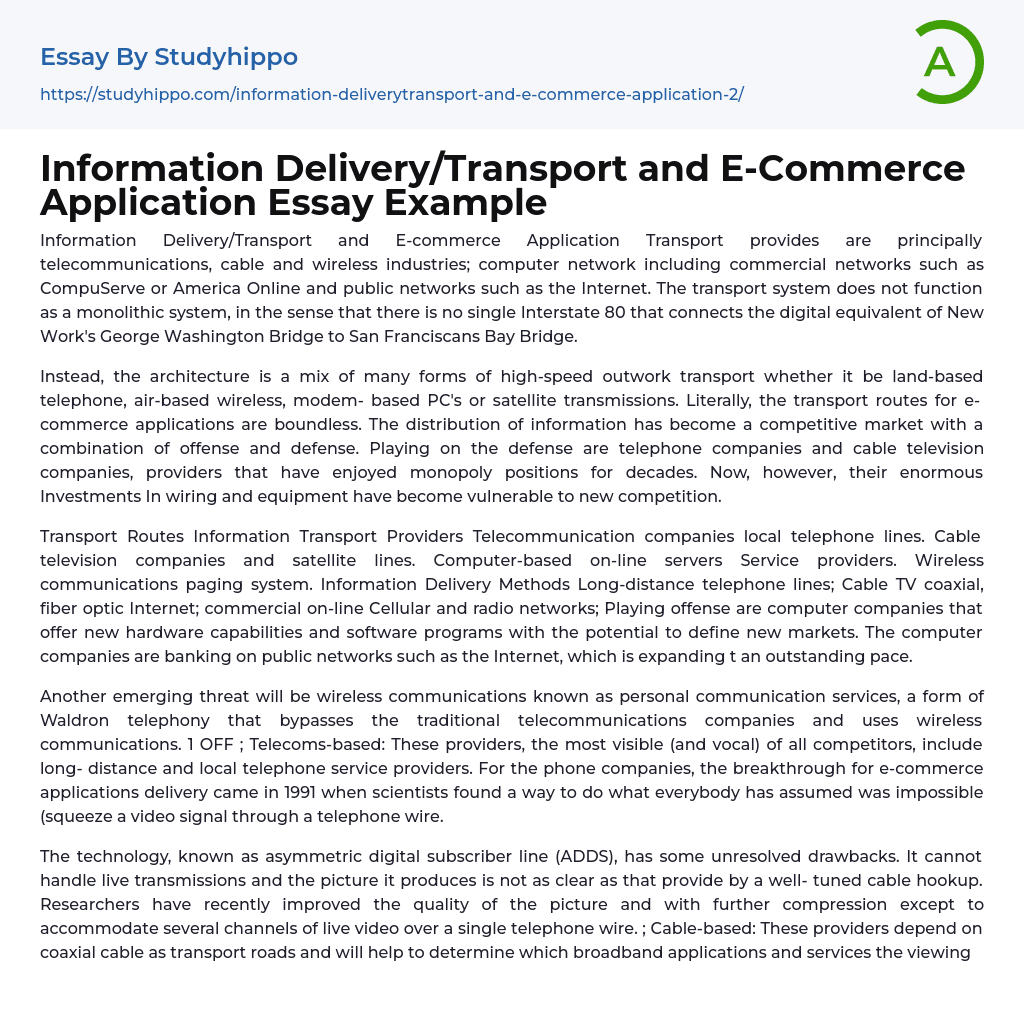

Information Delivery/Transport and E-Commerce Application Essay Example
Information Delivery/Transport and E-commerce Application Transport provides are principally telecommunications, cable and wireless industries; computer network including commercial networks such as CompuServe or America Online and public networks such as the Internet. The transport system does not function as a monolithic system, in the sense that there is no single Interstate 80 that connects the digital equivalent of New Work's George Washington Bridge to San Franciscans Bay Bridge.
Instead, the architecture is a mix of many forms of high-speed outwork transport whether it be land-based telephone, air-based wireless, modem- based PC's or satellite transmissions. Literally, the transport routes for e-commerce applications are boundless. The distribution of information has become a competitive market with a combination of offense and defense. Playing on the defense are telephone companies and cable television companies, providers that have enjoyed monopoly positions for decades. Now, however, their enormous In
...vestments In wiring and equipment have become vulnerable to new competition.
Transport Routes Information Transport Providers Telecommunication companies local telephone lines. Cable television companies and satellite lines. Computer-based on-line servers Service providers. Wireless communications paging system. Information Delivery Methods Long-distance telephone lines; Cable TV coaxial, fiber optic Internet; commercial on-line Cellular and radio networks; Playing offense are computer companies that offer new hardware capabilities and software programs with the potential to define new markets. The computer companies are banking on public networks such as the Internet, which is expanding t an outstanding pace.
Another emerging threat will be wireless communications known as personal communication services, a form of Waldron telephony that bypasses the traditional telecommunications companies and uses wireless communications. 1 OFF ; Telecoms-based: These providers, the most visible (and vocal) of
all competitors, include long- distance and local telephone service providers. For the phone companies, the breakthrough for e-commerce applications delivery came in 1991 when scientists found a way to do what everybody has assumed was impossible (squeeze a video signal through a telephone wire.
The technology, known as asymmetric digital subscriber line (ADDS), has some unresolved drawbacks. It cannot handle live transmissions and the picture it produces is not as clear as that provide by a well- tuned cable hookup. Researchers have recently improved the quality of the picture and with further compression except to accommodate several channels of live video over a single telephone wire. ; Cable-based: These providers depend on coaxial cable as transport roads and will help to determine which broadband applications and services the viewing public prefers.
All leading cable providers are conducting trials with a variety of hardware and software, and most are expected to use fiber optic cable and coaxial wire as the delivery medium. The strategy among cable companies is to develop a "network neutral" content that uses digital compression and is adaptable to alternative delivery systems, such as wireless and satellites. ; Computer network-based: These providers are often dial-up linkages of lower bandwidth when compared to telecoms and cable highways. Bandwidth is analogous to the number of lanes on a highway.
Examples of on-line transport architectures are CompuServe, Prodigy and America Online, which often tend to serve as both a transport road and content providers. ; Wireless: These operators are typically radio-based (cellular), satellite and light-based (infra-red). In fact, some of the most exciting transport architectures are invisible. New wireless-based systems require new ways of thinking about
information delivery. The sass have been characterized by record-breaking growth in most airless segments, including cellular, paging and specialized mobile radio.
This thriving market, considered to have enormous growth potential through the year 2000 and beyond, was further boosted in 1993-1994 by a series of legislative and regulatory developments encouraging emerging wireless technology. Currently, about 65% of e-commerce applications are delivered online via computers equipped with modems, but the percentage of information delivered on CD-ROOM continues to grow. Information delivery by telephone called auditioned, is a overspent regulations that have curtailed its growth.
- Networking essays
- Telecommunication essays
- Network Topology essays
- Telecommunications essays
- Email essays
- Hypertext Transfer Protocol essays
- Marshall Mcluhan essays
- Virtual Learning Environment essays
- Web Search essays
- Etiquette essays
- Mainstream essays
- Vodafone essays
- Web Search Engine essays
- Android essays
- Application Software essays
- Benchmark essays
- Computer Network essays
- Computer Programming essays
- Computer Security essays
- Computer Software essays
- Cryptography essays
- Data collection essays
- Data Mining essays
- Graphic Design essays
- Information Systems essays
- Internet essays
- Network Security essays
- Website essays
- World Wide Web essays
- Automotive essays
- Automotive Industry essays
- Commerce essays
- Construction essays
- E Commerce essays
- Grocery stores essays
- Paper Industry essays
- Pharmaceutical industry essays
- Pharmacy essays
- Polymers essays
- Real Estate essays
- Textile Industry essays



